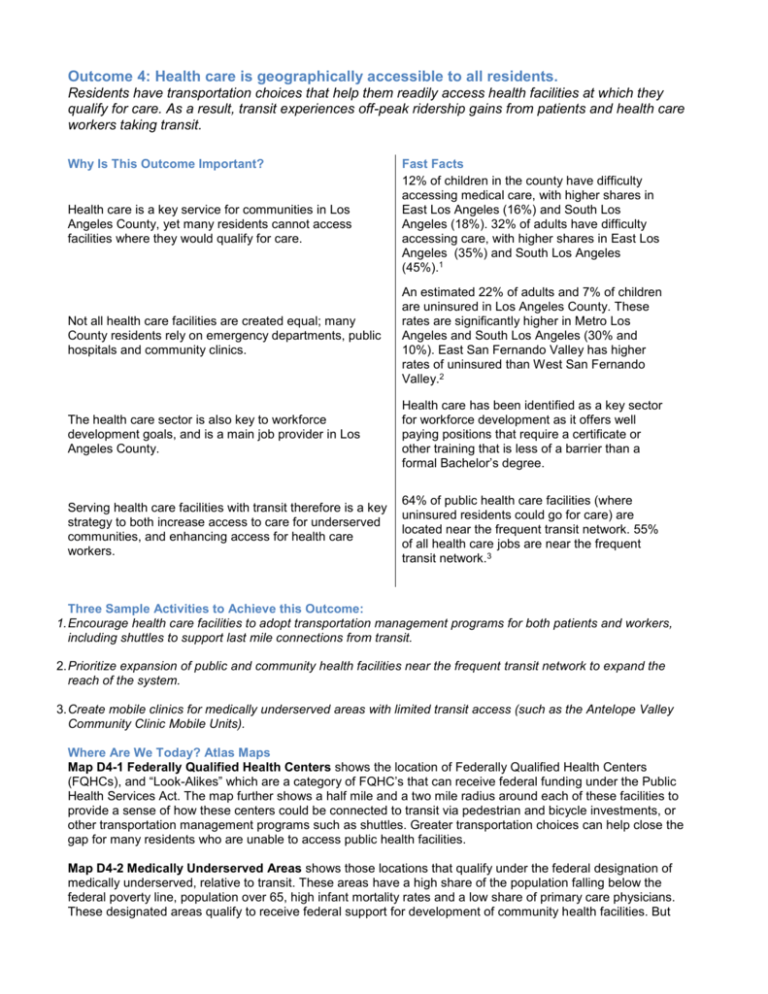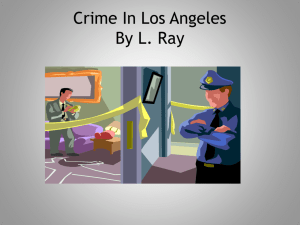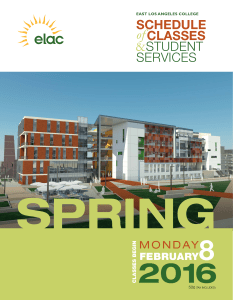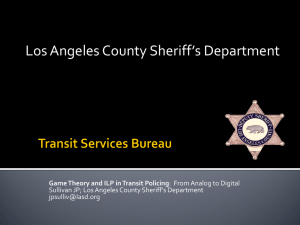Outcome 4: Health care is geographically accessible to all residents.
advertisement

Outcome 4: Health care is geographically accessible to all residents. Residents have transportation choices that help them readily access health facilities at which they qualify for care. As a result, transit experiences off-peak ridership gains from patients and health care workers taking transit. Why Is This Outcome Important? Health care is a key service for communities in Los Angeles County, yet many residents cannot access facilities where they would qualify for care. Fast Facts 12% of children in the county have difficulty accessing medical care, with higher shares in East Los Angeles (16%) and South Los Angeles (18%). 32% of adults have difficulty accessing care, with higher shares in East Los Angeles (35%) and South Los Angeles (45%).1 Not all health care facilities are created equal; many County residents rely on emergency departments, public hospitals and community clinics. An estimated 22% of adults and 7% of children are uninsured in Los Angeles County. These rates are significantly higher in Metro Los Angeles and South Los Angeles (30% and 10%). East San Fernando Valley has higher rates of uninsured than West San Fernando Valley.2 The health care sector is also key to workforce development goals, and is a main job provider in Los Angeles County. Health care has been identified as a key sector for workforce development as it offers well paying positions that require a certificate or other training that is less of a barrier than a formal Bachelor’s degree. Serving health care facilities with transit therefore is a key strategy to both increase access to care for underserved communities, and enhancing access for health care workers. 64% of public health care facilities (where uninsured residents could go for care) are located near the frequent transit network. 55% of all health care jobs are near the frequent transit network.3 Three Sample Activities to Achieve this Outcome: 1. Encourage health care facilities to adopt transportation management programs for both patients and workers, including shuttles to support last mile connections from transit. 2. Prioritize expansion of public and community health facilities near the frequent transit network to expand the reach of the system. 3. Create mobile clinics for medically underserved areas with limited transit access (such as the Antelope Valley Community Clinic Mobile Units). Where Are We Today? Atlas Maps Map D4-1 Federally Qualified Health Centers shows the location of Federally Qualified Health Centers (FQHCs), and “Look-Alikes” which are a category of FQHC’s that can receive federal funding under the Public Health Services Act. The map further shows a half mile and a two mile radius around each of these facilities to provide a sense of how these centers could be connected to transit via pedestrian and bicycle investments, or other transportation management programs such as shuttles. Greater transportation choices can help close the gap for many residents who are unable to access public health facilities. Map D4-2 Medically Underserved Areas shows those locations that qualify under the federal designation of medically underserved, relative to transit. These areas have a high share of the population falling below the federal poverty line, population over 65, high infant mortality rates and a low share of primary care physicians. These designated areas qualify to receive federal support for development of community health facilities. But connecting these areas to other qualifying health facilities via transit may also be a strategy to support increased access among the population living in these areas. Map D4-3 Health Care Facilities and Residential Location of Health Care Workers provides a sense of how the ability of health care employees to take transit to work may vary depending on the residential and work location of employees. A higher share of health care workers live closer to Orange or Ventura Counties, and many workers commute from Santa Clarita, making a transit commute challenging for a worker commuting at offpeak hours. A high share also live in the San Gabriel Valley, suggesting that the transit expansion into the Valley along the Foothill Extension and Eastside Extension could increase potential access to jobs from those locations. Sources and References 1 Los Angeles County Department of Public Health, Office of Health Assessment and Epidemiology. Key Indicators of Health by Service Planning Area; March 2013. 2 Cousineau, Michael R, PhD, “Health and Health Care Access in Los Angeles County,” University of Southern California, Keck School of Medicine, August 2009. http://www.patbrowninstitute.org/documents/HPOCReport8-20-09.pdf 3 2010 Longitudinal Employer Household Dynamics. Health Care is determined by using NAICS code 62, Health Care and Social Assistance Other Resources Antelope Valley Community Clinic: http://www.avclinic.org/ Hasenfeld, Zeke, “Spread Thin: Human Services Organizations in Poor Neighborhoods,” Center for Civil Society, UCLA Luskin School of Public Affairs, 2013. http://civilsociety.ucla.edu/practitioners/publications/spread-thinhuman-services-organizations-poor-neighborhoods California Office of Statewide Health Planning & Development, “California Healthcare Atlas” http://gis.oshpd.ca.gov/atlas/








